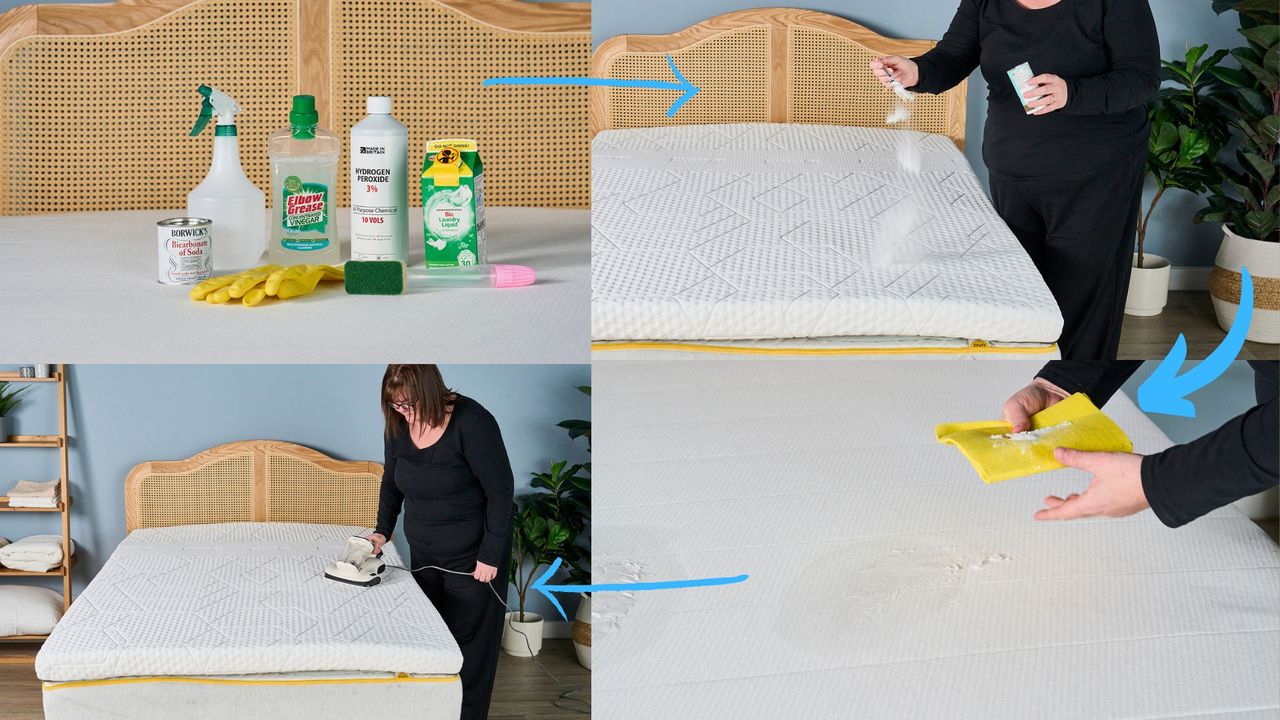
Mattress toppers add comfort, support and even an extra lease of life to any mattress. They also add an extra layer between you and your mattress, so they end up bearing the brunt when it comes to a buildup of dust, sweat, dead skin cells and the occasional spill or accident.
But that means it's essential you know how to clean your mattress topper properly. So, if you've invested in one of the best mattress toppers, it deserves some TLC. You don’t need to deep clean it every week but some regular maintenance will help keep bacteria, allergens, stains and smells at bay.
In this guide, we're walking through everything you need to know about cleaning your mattress topper, from quick cleaning hacks to deep stain removal.
Quick mattress topper cleaning hacks
Keep reading if you want a full in-depth guide on how to clean your mattress topper. But if time is short and you’re in a rush, here are some quick mattress topper cleaning hacks.
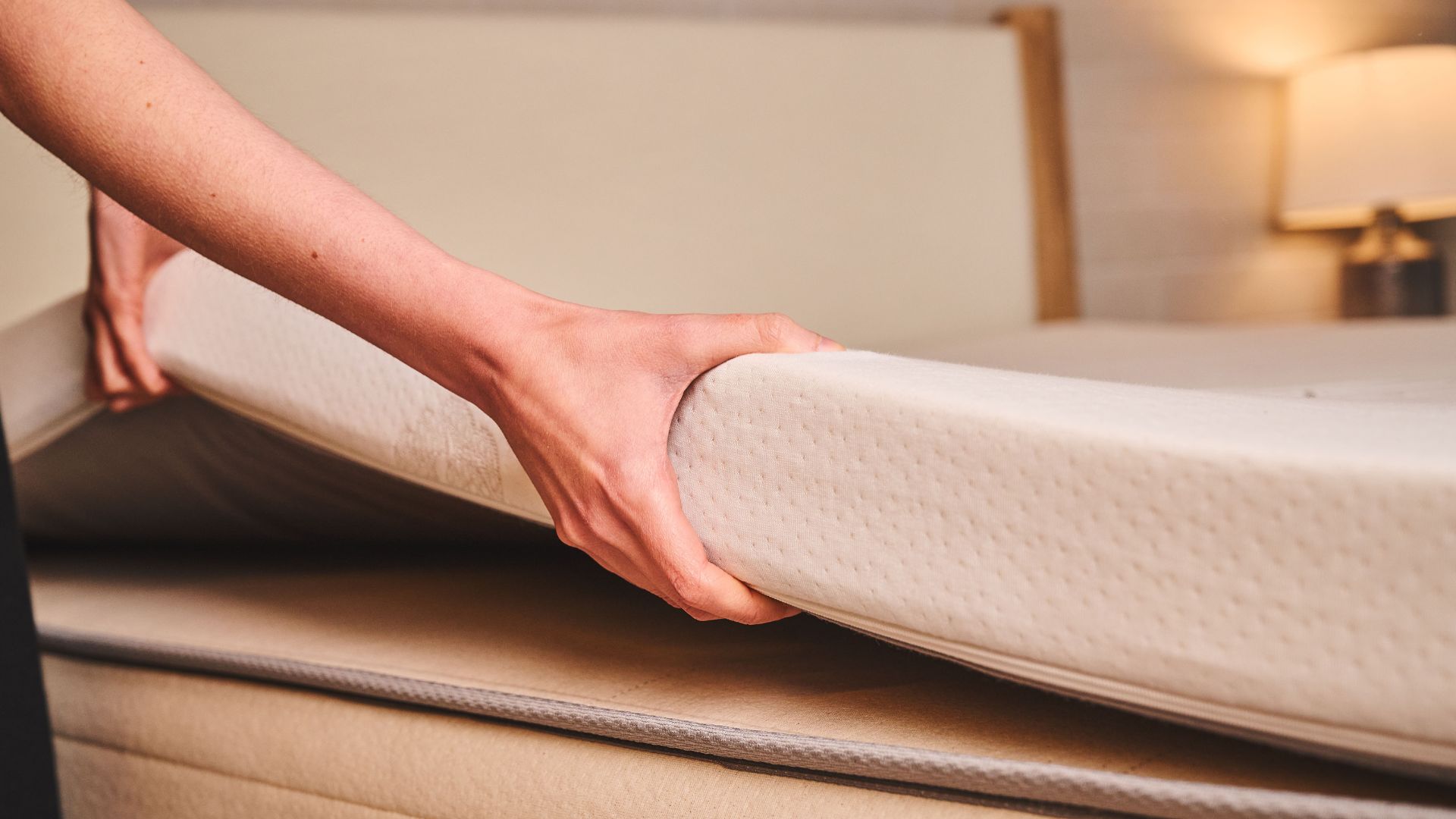
• Vacuum: Just like cleaning a mattress, you should vacuum your topper on a regular basis. Use the upholstery attachment to ensure you don’t cause any damage to the fabric or materials.
• Sprinkle with baking soda: Baking soda is a great way to deodorize your mattress topper. After vacuuming, sprinkle a generous layer on the surface and leave for a couple of hours, once it’s rested simply vacuum it up.
• Spot clean stains: Tackle stains as soon as you see them by spot cleaning with a mixture of water and white vinegar. Lightly spray the mixture and then blot dry with a clean paper towel.
• Air your topper: Don’t rush to pop your bed sheets back on once you’ve stripped them, instead, leave your mattress topper to air for a couple of hours. Place in a well-ventilated room and leave the air to circulate.
• Grab your handheld steamer: A quick blast of steam will kill any germs, freshen and sanitise your mattress cleaner. Just be mindful not to oversaturate your bed and always leave it fully dry before sleeping on it. If your mattress topper is made using memory foam, latex or organic materials, this method isn’t suitable.
How to clean a mattress topper: What you’ll need
You don’t need to invest in any fancy products to keep your mattress topper clean. You can achieve great results using some household staples. Here’s what you need to wash your mattress topper.
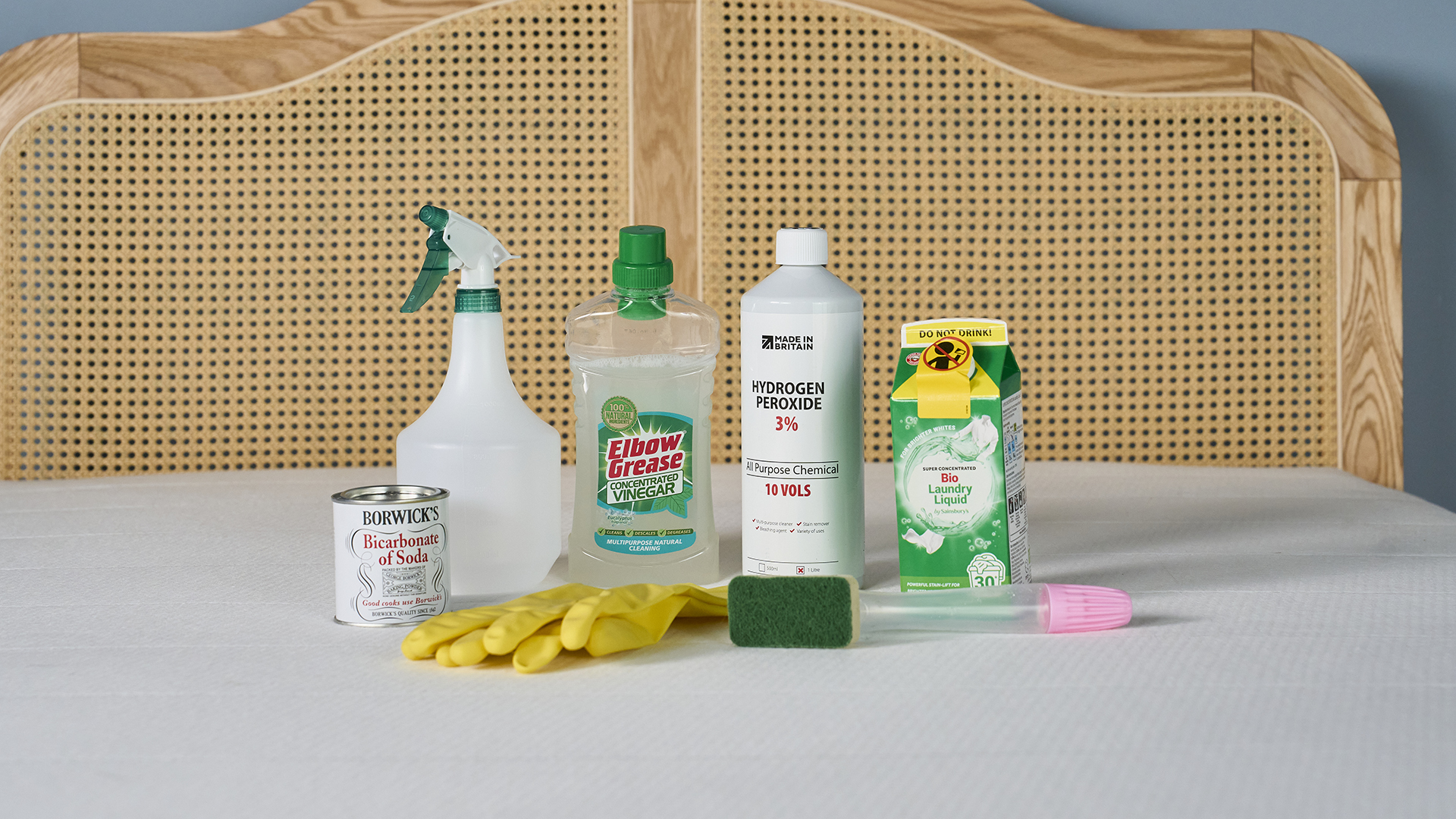
• Baking soda: This will help to absorb any excess moisture, deodorize funky smells and also help to lift stains.
• White vinegar: Acts as a stain remover (especially when used with baking soda) and also is a natural disinfectant.
• Hydrogen peroxide 3%: This will help to lift protein stains like urine, blood and sweat.
• Mild laundry detergent: Ideal for spot cleaning stains or hand-washing.
• A vacuum with an upholstery attachment: For removing surface dust and debris, always use the attachment to avoid damage to the mattress topper surface.
• Clean white microfiber cloths or paper towels: You’ll need these for blotting and drying. Use white to avoid any of the dye transferring on to your mattress.
• A clean spray bottle: The key to cleaning your mattress topper is not to get it too wet, so use a spray bottle to control the amount of moisture.
How to wash a mattress topper: Type of topper
Memory foam
Just like the best memory foam mattresses, memory foam toppers need special attention. Memory foam is super absorbent, which means it will soak up liquids quickly but dry slowly. Memory foam also doesn’t respond well to heat as it can degrade the foam so methods like steam cleaning are also a huge no-no. To clean a memory foam topper, follow these steps:
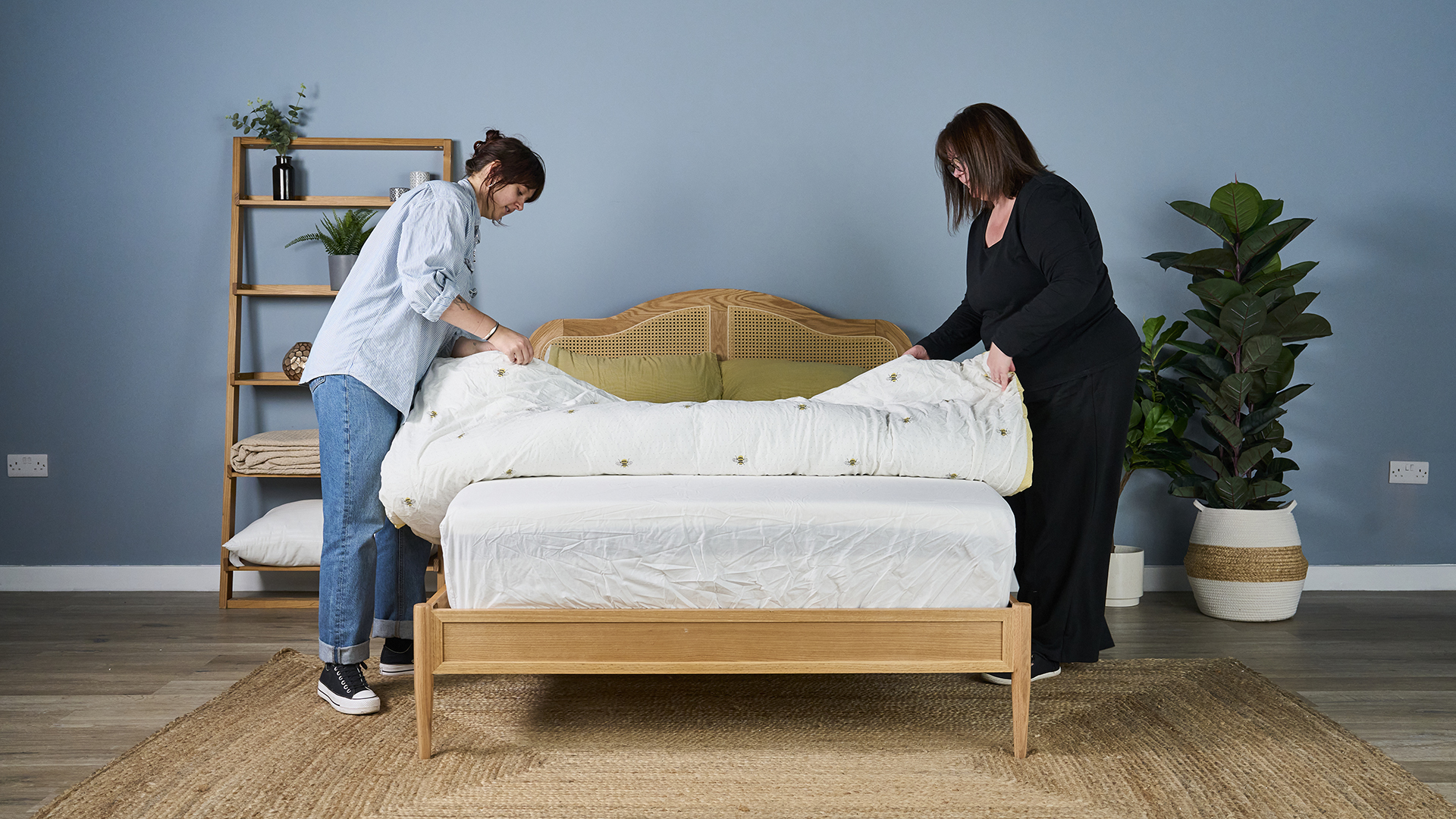
Step 1. Remove the sheets: Strip your bed, including your mattress protector.
Step 2. Vacuum the surface thoroughly: Using an upholstery attachment, vacuum the surface of your topper to remove any loose dust, debris and allergens.
Step 3. Spot clean any stains: Mix together a couple of drops of mild laundry detergent with some warm water and blot the stain. Then with a clean cloth dipped in cold water, just blot again to remove any detergent residue. Blot again with a clean, dry cloth to remove any excess moisture. Always leave the mattress to fully dry.
Step 4. Deodorize using baking soda: Sprinkle a layer of baking soda over your mattress topper and leave for around 4 hours, if you’re in a hurry you can vacuum it off after an hour but the longer you leave it, the better.
Step 5. Leave to air dry: Leave your mattress to fully air dry in a well-ventilated room. Remember not to use any heat (such as a hair dryer) to speed up the drying process as this will damage the structure of your topper.
Latex
Latex toppers are made from a natural rubber sap which is durable but sensitive to moisture, heat and harsh chemicals. So, just like memory foam, they need special attention.
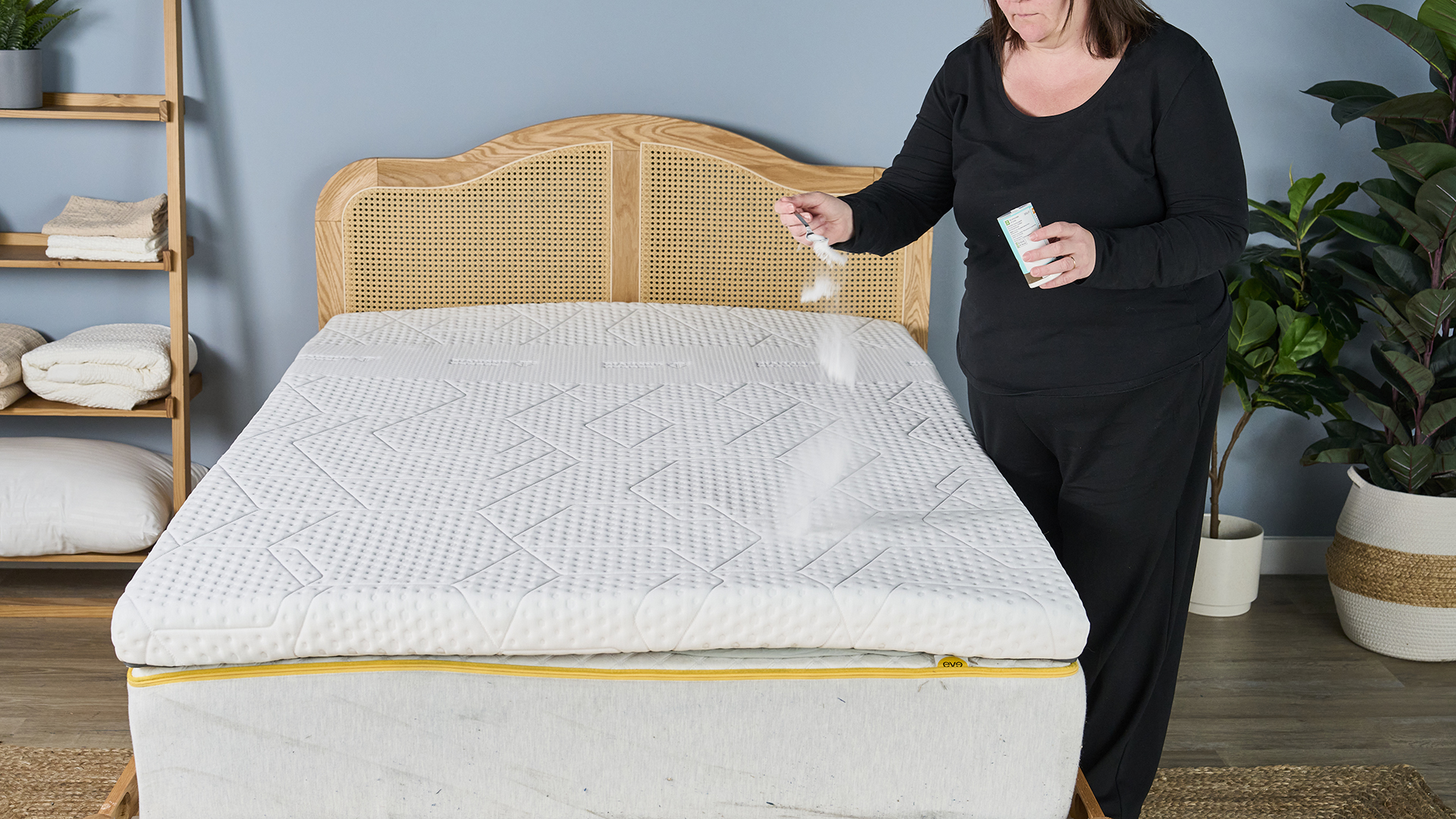
Step 1. Remove the sheets: Strip your bed and lay the topper on a flat surface.
Step 2. Vacuum your mattress: Remember that latex can be sensitive so always use the upholstery attachment and vacuum the surface of the mattress to get rid of any debris.
Step 3. Spot clean stains: If you notice any stains, then grab a clean spray bottle and mix a few drops of mild detergent and cold water and spray the area being mindful not to over-saturate. Next get a clean cloth and dab at the stain to start lifting. If it’s a deep stain, massage in some baking soda and leave it to dry for around 20 minutes before wiping it away.
Step 4. Deodorize with baking soda: Sprinkle baking soda across the surface, you may want to add a few drops of essential oil before you spread it. Then leave to sit for around four hours before vacuuming to remove the powder.
Step 5. Air dry your mattress: Blot any excess moisture with a dry towel. Then leave your latex mattress topper to dry in a well-ventilated room. Keep your topper out of direct sunlight and away from heat (like radiators) but you could use a fan if you want to speed up the process. Depending on the thickness of your topper you may want to flip it to ensure it’s dry on both sides.
Organic
Organic toppers are made from natural materials like bamboo, cotton and wool, which means that they need a more delicate approach to washing.
Organic toppers can shrink, warp or clump together if cleaned too aggressively. Much like memory foam and latex, organic mattress toppers shouldn’t get too wet, and shouldn’t be exposed to heat or harsh chemicals.
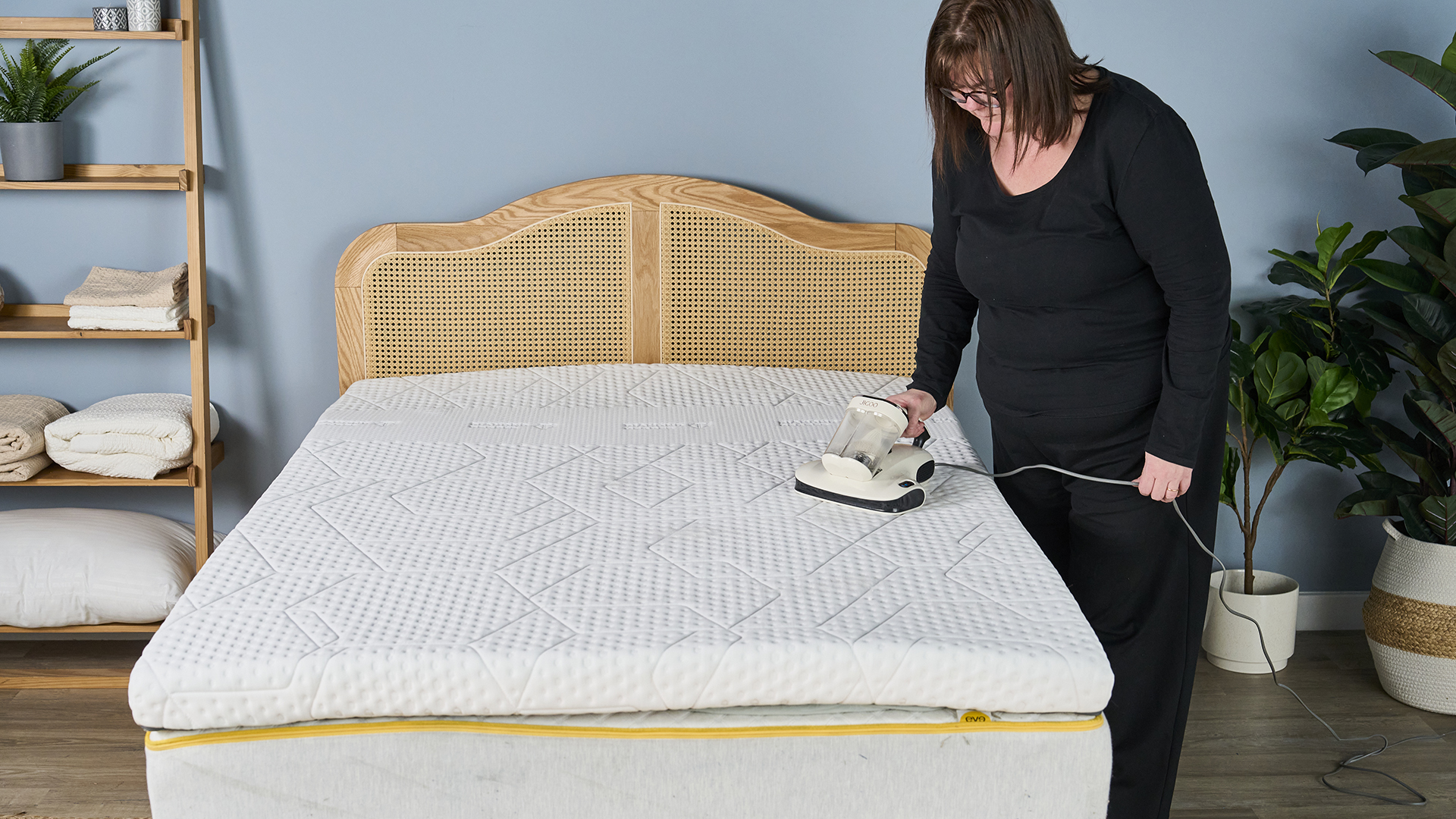
Step 1. Remove your sheets: Remove all your bedding and set your topper flat in a well ventilated area. It’s best to remove it from your mattress so that you don’t risk any moisture seeping into the mattress.
Step 2. Vacuum both sides: Vacuum your mattress topper to remove any dust and debris that may be on the surface. Flip it over and do both sides. Remember to use the upholstery attachment so that it doesn’t damage the materials.
Step 3. Deal with stains: Mix together an equal part of water and white vinegar and apply to the stain. Blot gently to start lifting the stain before taking a clean, dry cloth and blotting again.
Step 4. Use baking soda: Using baking soda, sprinkle over the topper and leave it to rest for a couple of hours (ideally a minimum of four, but the longer you can leave it the better). This will help absorb any excess moisture and neutralise odors.
Step 5. Brush the topper: Using a soft bristle brush, work it around the topper to fluff up the fibers and restore the loft.
Step 6. Ensure the topper is dry: Organic toppers can take a long time to dry so make sure you give yourself plenty of time. You need to make sure your topper is fully dry before sleeping on it. Leave in a well-ventilated room and turn often so ensure it's dry on both sides.
Down
Down toppers can be a lot easier to clean as most are machine washable. However, just double-check the care label first as your particular brand could be blended with other materials. If you’re unsure, follow the steps above for an organic topper.

Step 1. Remove the bedding: Remove all bedding and place in the wash whilst you continue the cleaning process.
Step 2. Vacuum: Vacuum the surface to get rid of any embedded dirt and dust. Do this on both sides and make sure to use the upholstery setting. Once you’ve vacuumed it, remove it from the bed.
Step 3. Pre-treat stains: Deal with any stains by making a homemade cleaning paste. Mix together two tablespoons of baking soda with one tablespoon of water and a dash of white vinegar. Add more baking soda if your mixture is too runny. Apply this to the stain and gently massage it in before leaving it for around 30 minutes. Wipe off with a damp cloth and then blot dry.
Step 4. Wash on a gentle cycle: If your topper is machine washable, add to your machine and select a delicate or wool cycle. Use a small amount of detergent (around half the amount you’d use on a regular load). The water temp should be cold or lukewarm, never hot.
Step 5. Run a rinse cycle: Run your topper through a rinse cycle on cold water to make sure there’s no detergent left behind.
Step 6. Dry fully: Check the care settings but if your mattress topper is dryer-friendly then tumble dry on a low heat setting. Add two tennis or dryer balls to help it evenly dry and to fluff the down. Check and fluff your topper every 30-40 minutes.
How to clean a mattress topper: Removing stains
Urine
• Baking soda
• White vinegar
• Hydrogen peroxide
• Clean towels or cloths
• Spray bottle
Urine stains can cause yellowing and bad smells, they can also be stubborn. But it’s important to tackle them as soon as possible.
Accidents happen so always remove as much liquid as possible when it first happens to avoid the stain becoming deep set.
1. Fill a spray bottle with equal parts white vinegar and water. Spray this on the stain and blot to remove any excess moisture as well as start to lift the stain.
2. Sprinkle baking soda over the damp area and leave for around six hours, but the longer you can leave it, the better.
3. Once the baking soda has dried, vacuum the area thoroughly.
If the stain isn't budging, try adding a couple of drops of mild detergent to hydrogen peroxide. Apply this to the stain and then blot the area to start lifting it. Then repeat the baking soda step before leaving the topper to fully dry.
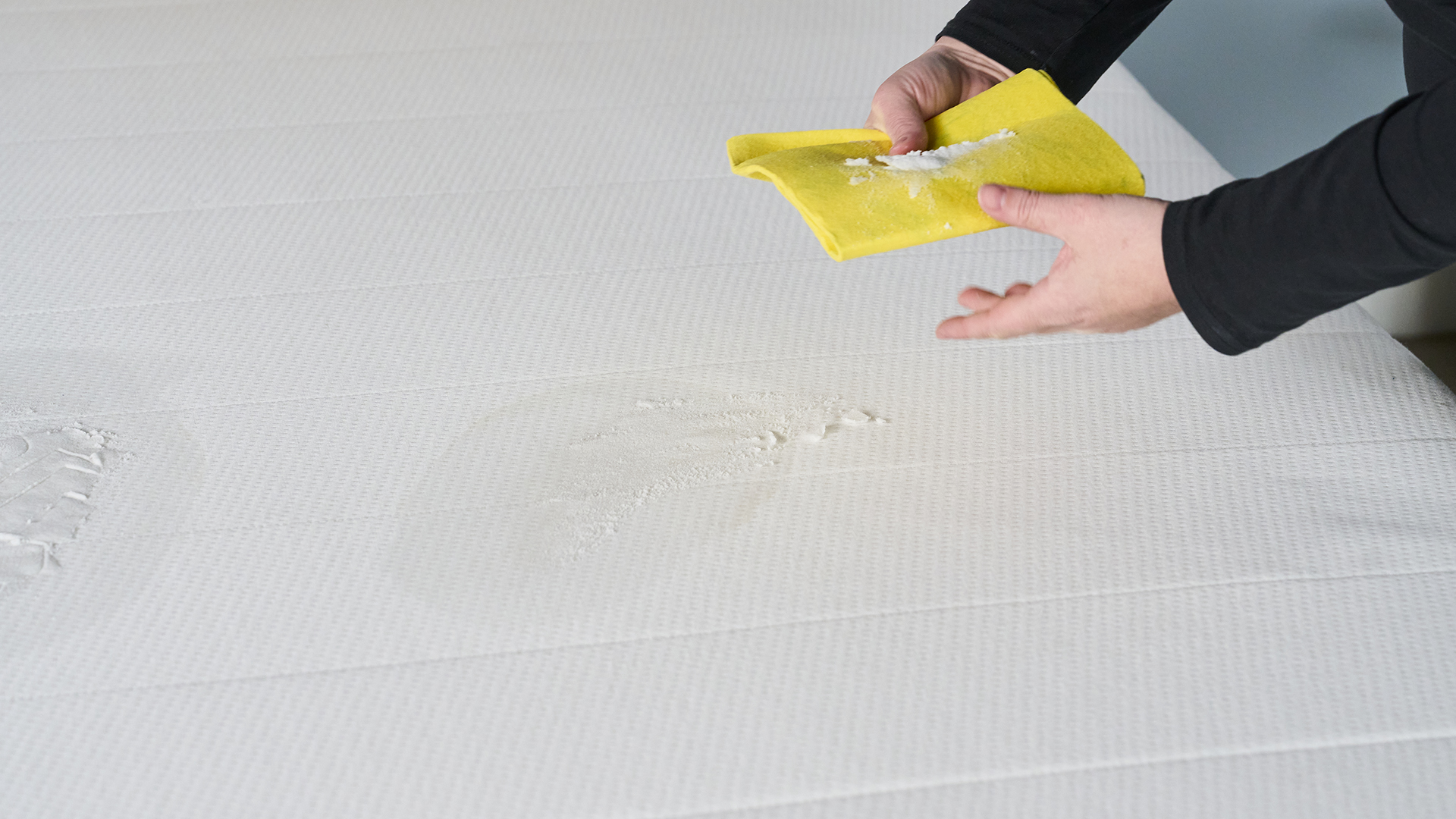
Blood
• Hydrogen peroxide
• Baking soda
• Cold water
• Clean microfiber cloths
One thing to remember when dealing with blood stains is they should always be treated with cold water, not hot. Hot water can push the stain deeper in to the fibers making it more difficult to remove.
1. Dab the stain with a clean microfiber cloth and cold water.
2. Apply hydrogen peroxide directly to the stain and leave it to work, you may notice it starts to fizz.
3. Blot the area dry with a clean cloth or paper towel.
After you’ve done this, next apply a generous layer of baking soda and leave it sit for around an hour, if you can, leave it longer. Then vacuum it away when it’s dry. If the stain is deep or old, you may have to repeat these steps a couple of times.
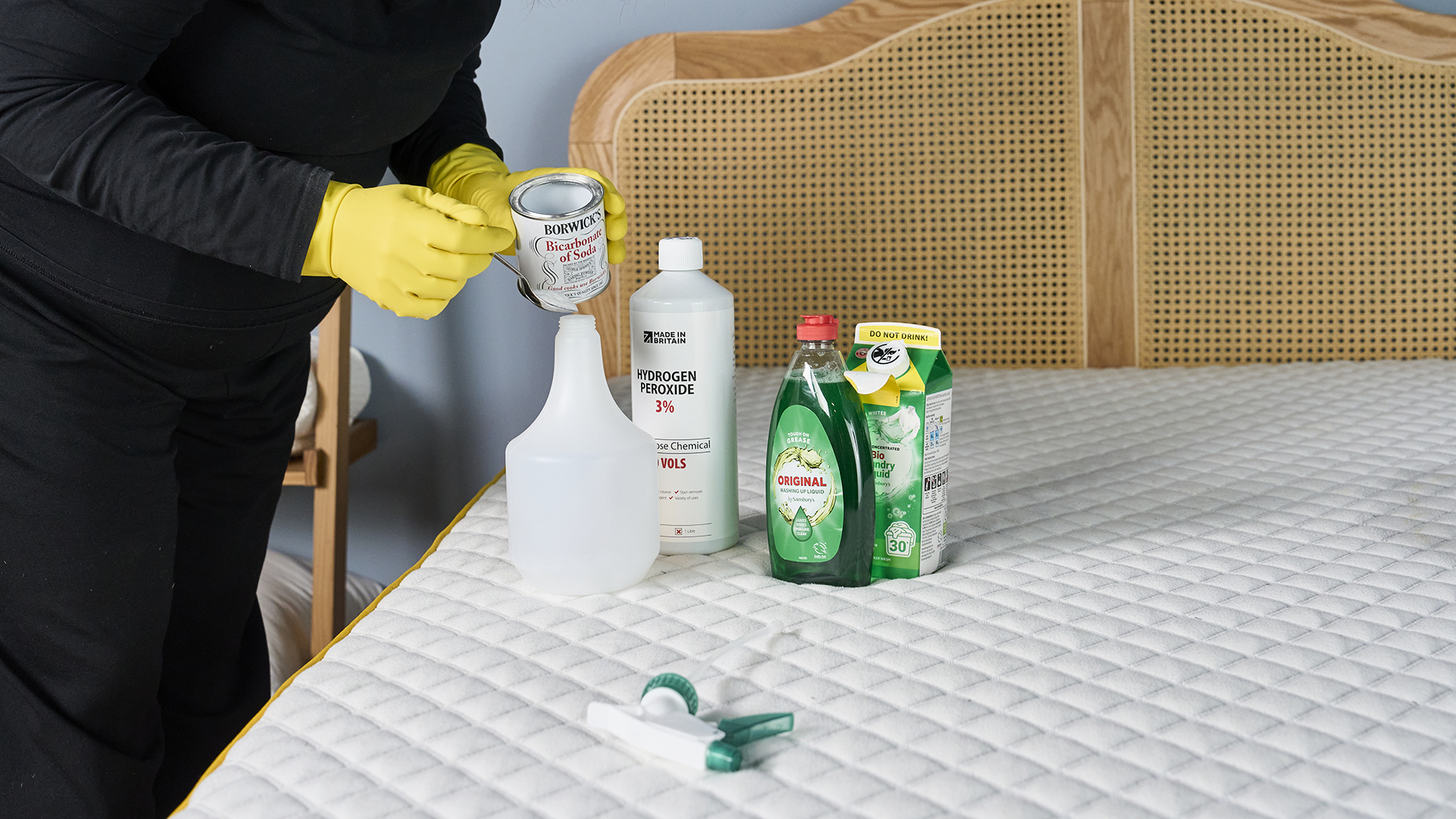
Vomit
- Baking soda
- White vinegar
- Mild detergent
- Spray bottle
- Towels
You need a triple-pronged approach when cleaning vomit as you need to tackle the bacteria, the smell and the stain.
First thing you need to do is to get rid of any solids that remain on the topper. Do this with paper towels and don’t forget to use your gloves.
1. Spray white vinegar directly onto the stained area.
2. Blot dry and then using a mixture of water with a couple of drops of detergent, gently scrub at the stain. Don’t rub as you don’t want to risk pushing the stain out further.
3. Blot the area dry and then apply a layer of baking soda and leave to dry. This should be for at least four to six hours, but if you can, leave it longer.
4. Vacuum the baking soda and leave to air dry.
If the smell remains, you may want to spritz the area with rubbing alcohol. This will help sanitize the area, killing bacteria that could be causing the odors.
It also evaporates quickly, meaning it’ll dry fast. Just be wary of using it on materials like memory foam or latex.

Sweat
• Baking soda
• Hydrogen peroxide
• Mild detergent
• Spray bottle
• Clean cloths
We sweat a lot whilst we sleep and even if you regularly change the sheets, that sweat will seep into the fabric of your mattress topper over time. This doesn’t just cause funky odors but also yellow stains.
1. Make a stain remover by mixing a 1/2 cup of hydrogen peroxide and a tablespoon of baking soda in a clean spray bottle.
2. Apply this directly to the stained area and leave for 30 minutes to an hour.
3. After it’s had time to sit, take a clean, dry cloth and start blotting to remove the excess moisture and lift the stain.
Leave your mattress topper to dry completely and air it by leaving it in a well-ventilated room with the windows open for a couple of hours. You will need to repeat this process weekly for stubborn sweat stain build-up.

How to remove bed bugs
Mattresses and mattress toppers are an ideal environment for bed bugs and dust mites to thrive. If you think you have an infestation, then first vacuum your mattress. Empty this outside into a sealed bag to prevent the spread of bed bugs around your house.
If your mattress topper isn't made with memory foam, steam clean it to kill any remaining live bugs and their eggs. If your topper is made from foam, leave it in direct sunlight for a few hours to kill bugs and eggs.
Remember that prevention is better than cure, so it’s best to invest in one of the best mattress protectors or encasements to keep your mattress topper protected. Also make sure to wash all bedding on a high heat to kill any eggs that may be on your sheets.
For large-scale infestations, you might need to get rid of your current mattress topper.
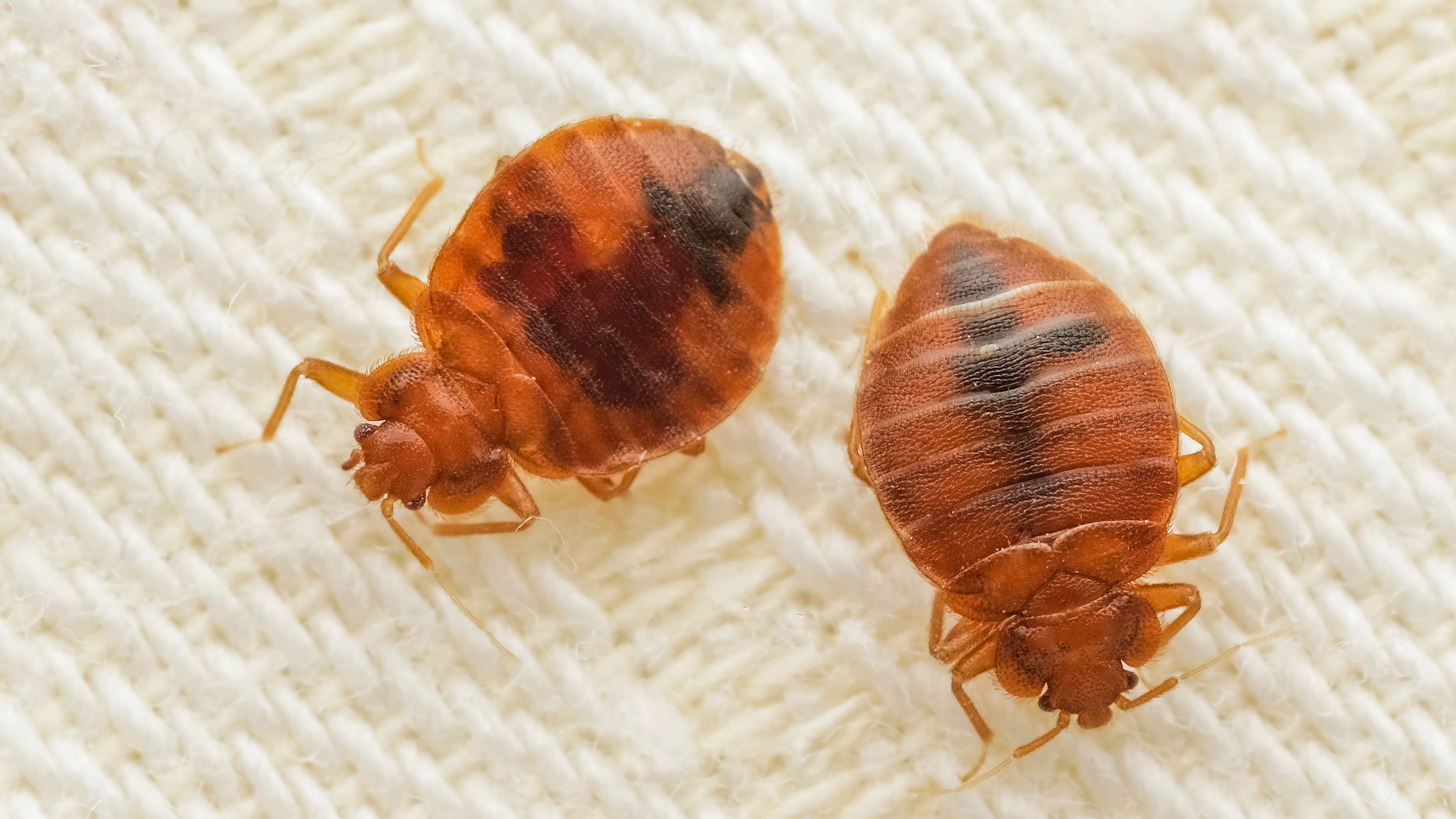
How to get rid of topper mold
Topper mold is often caused when your topper has been exposed to excess moisture or if it’s used in an environment where there is high humidity. Signs that you have mattress mold often include a musty smell that you can’t get rid of or dark spots.
If you suspect topper mold, deal with it as soon as possible by vacuuming both sides to remove any spores.
Then using a clean spray bottle spray a mixture of white vinegar and water and scrub with a clean cloth. Leave your topper to air dry full before putting it back on your bed.
The key is not to saturate your mattress topper as this can make mold even worse.If the mold is extensive or it keeps coming back, then it’s time to replace your mattress topper.
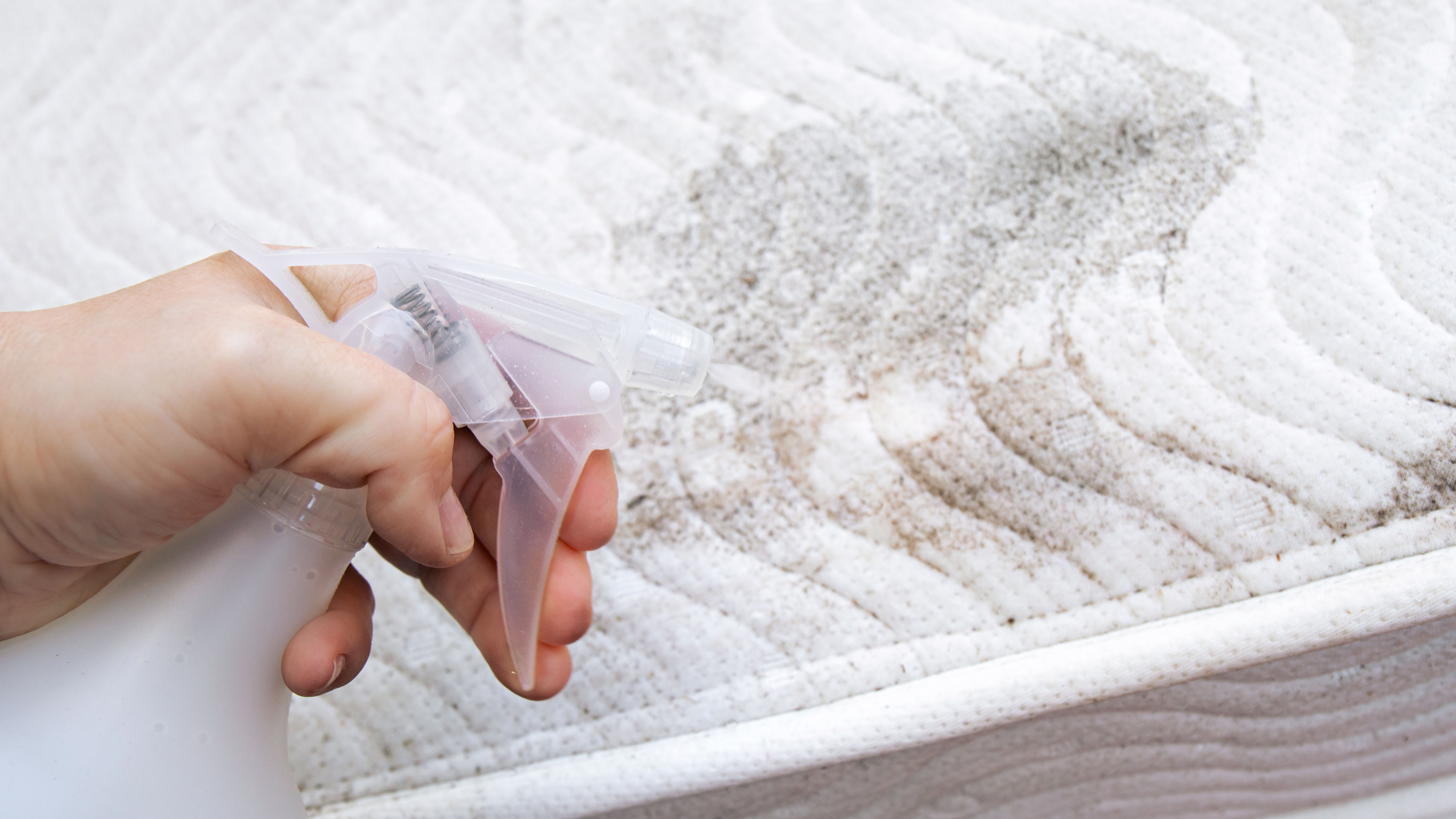
How to look after your mattress topper
Treat stains quickly
Never ignore stains on your mattress or your mattress topper. The longer you ignore a stain, the deeper it will set and the harder it will be to remove.
And they don’t just look unsightly, they can also cause damage to your mattress topper and your health.
The quicker you act, the better. Never use harsh chemicals either, you’re better sticking to natural solutions like baking soda and white vinegar for the best results.
Plus, remember never to rub a stain, as this will only spread it further and deeper. Also, opt for cold or luke warm water, as hot water can occasionally make a stain deeper.
Use a mattress protector
Accidents, spills, dead skin cells, sweat, body oils and more happen, and even if you change your sheets often, these can seep into the mattress topper below.
That’s why a mattress protector is essential and the first line of defence for your topper. This barrier, which can be waterproof and hypoallergenic, will shield your bed from damage.
Plus, most mattress protectors can be machine washed so they’re easy to keep clean. A good mattress protector won’t just help your mattress stay hygienic, it’ll also help improve the lifespan of your mattress and topper.
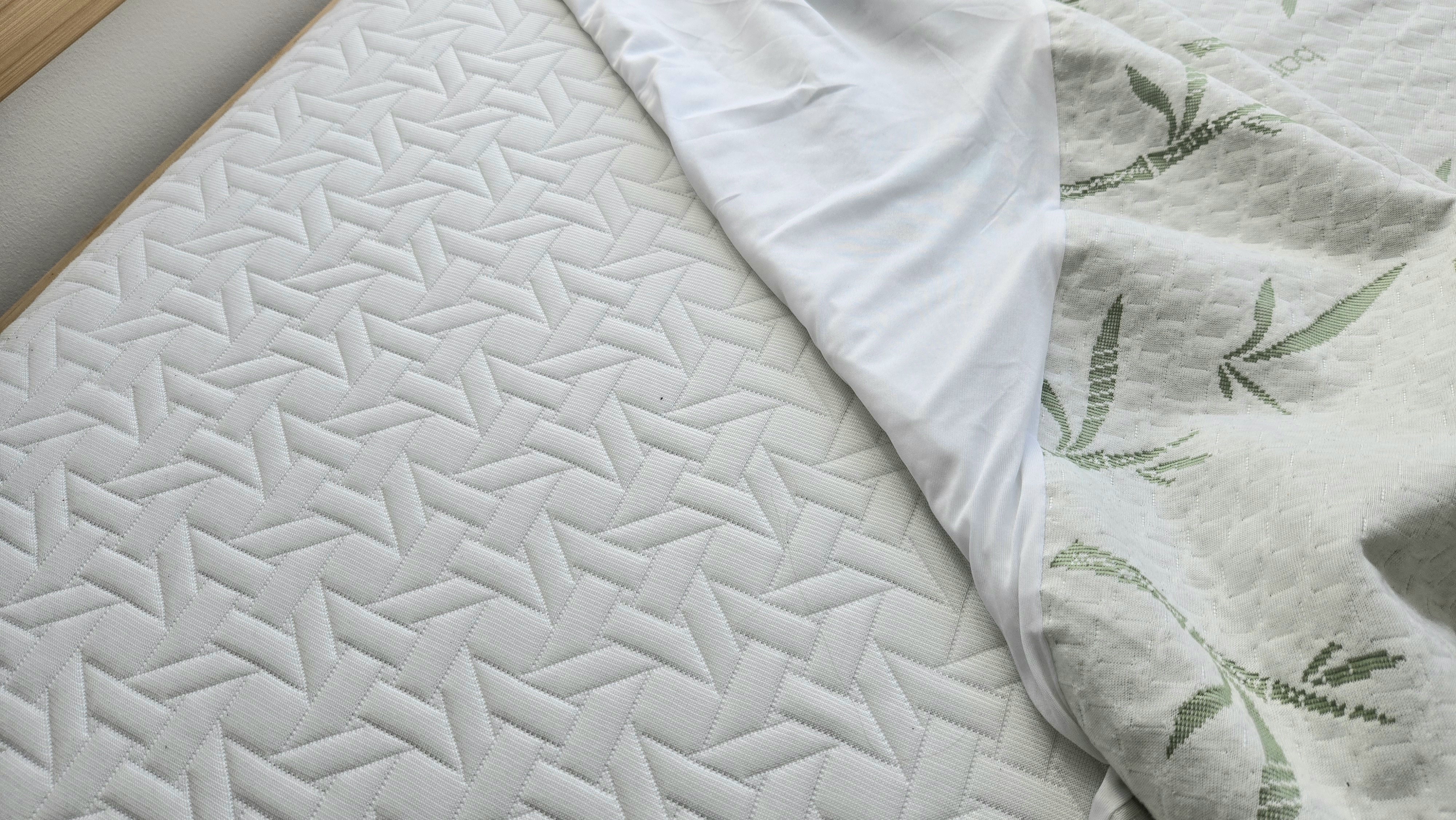
Vacuum often
We always advise vacuuming your mattress and your mattress topper, and it's for good reason.
Regularly vacuuming your mattress topper will lift any dust, debris, hair, pet dander and dead skin cells that can build up over time and cause stains and smells.
Vacuum your topper on both sides at least once a week using the upholstery tool. If you have time, you can sprinkle a layer of baking soda on and leave for at least four hours before vacuuming to freshen it up.
Vacuuming will maintain the freshness of your topper and help to reduce allergy symptoms.







